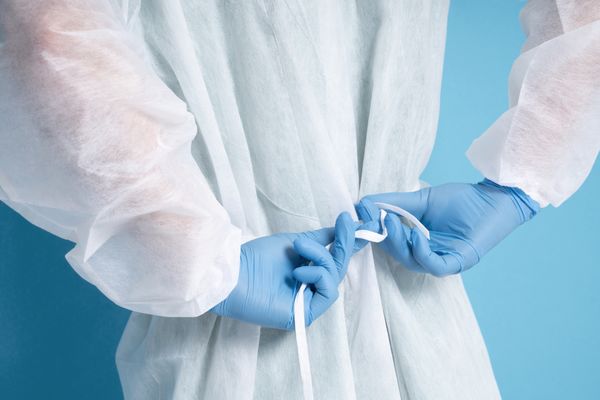TikTok trends regularly take the internet by storm, and while some are considered dangerous for the public, others end up being great life hacks for a variety of reasons.
Google searches for the latest trend, ‘ear seeding,’ have increased by 60% in the last few weeks, gaining almost 200 million views on TikTok.
Martin Seeley, the CEO and sleep expert at MattressNextDay has delved into the latest wellness trend to explain exactly what ear seeds are, how they work, and his top tips for applying them.
READ MORE: Terrifying video on TikTok shows group of teenagers 'scutting' on back of Dublin Bus
What are ear seeds?
The trend originates from a traditional Chinese medicinal method called auriculotherapy (commonly known as ear acupuncture), where ear seeds are applied to the acupuncture points on your ear.
Although the tiny seeds are applied to acupuncture points on the ear, they are in fact a needle-free version of acupuncture as they have an adhesive on them - which is how they remain in place.
Traditionally, ear seeds come from the flowering herb Vaccaria but nowadays, they are typically made of metal or ceramic.
In fact, there are even stylised beads, such as gemmed or nude-coloured beads that blend in with your skin tone, which has helped them go viral on TikTok - gaining almost 200 million views.
It is important to note that experts recommend removing ear seeds after 5 days of application.
How do they help you sleep?
Martin says, “Studies have shown that when they are applied correctly, they can help relieve pain, anxiety, depression, insomnia, and other ailments.
“Ear seeds can stimulate melatonin naturally when applied correctly. Melatonin is a hormone produced naturally in your brain by the pineal gland.
“It’s the hormone that helps regulate your day and night cycle, keeping your body clock in check, and can help with insomnia and jetlag.
“As it gets darker, your optic nerve signals your pineal gland so your body naturally produces more melatonin, preparing your body for sleep.
“On your ear, there is a corresponding auricular point for your pineal gland, which is located on the lower part of your tragus.
“Applying ear seeds to this point can help stimulate the development of melatonin in your body to combat insomnia.”
Eight simple steps for using ear seeds for the first time
Clean and dry the outside of your ear
As ear seeds come with pre-attached adhesive tape it’s vital to make sure your ears are clean before application.
“We recommend cleaning the outside of your ears with warm water and a washcloth or cotton pad.”
Use the chart to uncover the best pressure points for a better night’s sleep
Based on the symptoms you are looking to address, you should identify where on your ear you should apply ear seeds.
Most at-home kits come with charts showing the location of specific points for symptoms like anxiety and insomnia etc, alternatively, a trained acupuncturist can show you where they should be placed.
Use tweezers to apply your ear seeds to the pressure point
Typically ear seeds come pre-attached to adhesive tape; avoid touching the sticky side of the tape with your hands. Using your tweezers, pull the ear seeds off the sheet and apply it directly to your desired pressure point, press gently on the tape to make sure it sticks.
Watch out for any side effects over the next few days
Ear seeds are generally safe to use, they’re noninvasive and don’t use needles so there is a lower risk of infection or bleeding which comes with typical acupuncture.
However check your ears, due to the nature of ear seeds and the materials/adhesive on them, check your ears each day for signs of irritation such as; redness, swelling, soreness and tenderness.
If you experience any of these symptoms, remove the seeds right away.
Some side effects to be aware of include spells of dizziness, nausea and drowsiness.
Gently massage your ear seeds daily for three minutes
Depending on the severity of your symptoms, you should aim to massage your ear seeds two to three times each day or when you have symptoms.
Apply pressure by rubbing the seeds in a circular motion for up to three minutes. Avoid over-massaging your ear seeds as this can lead to the development of sores.
Remove them every five days
From everyday activities such as exercise, washing and even sleeping, ear seeds can fall off on their own. However, it's not recommended to leave them on for more than five days for hygiene reasons.
To remove them, it’s best to use tweezers, however, the most important thing to bear in mind when removing ear seeds is to ensure they don’t fall into your ear canal.
To stop this, tilt your head so your ear faces the ground before taking them out. If a seed does fall into your ear and doesn’t come out, contact your healthcare provider as soon as possible.
Take a break for 24 hours
Let your skin rest between the application of ear seeds, this is so the skin on your ears has time to breathe and recover from ear seeds - overuse and consistent reapplication can cause pain and sores on your ears in the long run.
You should ideally wait 24 hours before applying new ear seeds.
Are they not working? It’s time to go to a professional
If you have given self-application a go, yet you still aren't feeling the benefits of your ear seeds - it may be because you’ve applied them wrong.
Consider visiting a trained acupuncturist to reap the full benefits of ear seeds. By visiting a trained acupuncturist, they can walk you through the application of where on your ear you should apply ear seeds based on the symptoms you would like to address.
READ NEXT :
Social Welfare: Full list of people eligible for Christmas bonus due in matter of days
Evil double killer set for temporary release from prison over Christmas
Trump's Doonbeg golf resort recorded over €500,000 operating profit in 2021
Young boy remains in a serious condition after 'shocking' pitbull attack in Co Wexford
Get breaking news to your inbox by signing up to our newsletter







